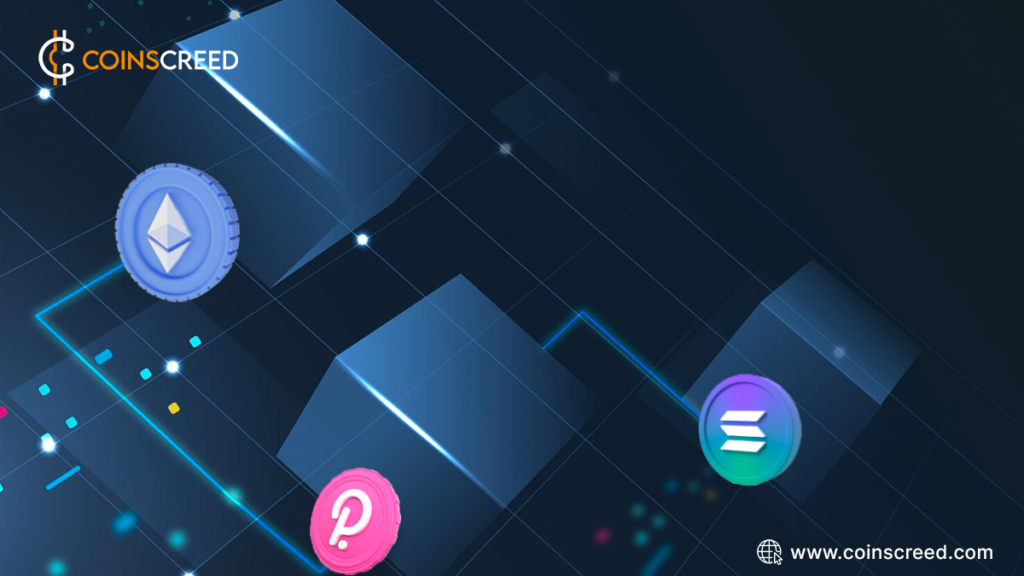Blockchain is essentially a distributed ledger that provides safety, security, and trust in a system without a central authority. However, Layer 1 blockchain protocols are the bedrock of this technology. These protocols also serve as the structural support structure for the whole blockchain ecosystem.

This article will explore three of the most well-known Layer 1 blockchain protocols: Ethereum, Polkadot, and Solana. While the blockchain industry has struggled with scalability, security, and interoperability issues for some time, each protocol takes a different approach to solving these problems.
Now, let’s look at what Layer 1 blockchain protocols and each of the protocols listed above.
What Are Layer 1 Blockchain Protocols
When discussing blockchain technology, “layer-1” refers to the protocol that forms the basis of the network. It’s a distributed ledger technology (DLT) that creates a public and immutable ledger to record transactions.
You can think of it as the building blocks upon which they develop more complex blockchains like dApps, smart contracts, and other features. It is the underlying support for the blockchain, also known as the “core” or “foundation” of the network upon which all subsequent apps and protocols are built.
This layer is responsible for defending the network from attacks, verifying transactions, and updating the distributed ledger. Furthermore, it uses a consensus process to verify and agree upon all transactions and the blockchain’s state. Delegated Proof of Stake (DPoS), Proof of Work (PoW), and many more are all examples of popular consensus procedures Layer 1 blockchain protocols use.
Some notable Layer 1 blockchain protocols include Ethereum, Polkadot, and Solana, which we will explain below. Each platform is best suited for a specific set of use cases within the larger blockchain ecosystem because of its unique rules, consensus methods, and capabilities.
Ethereum
Ethereum is a leading Layer 1 blockchain protocol that has significantly influenced the development of the decentralized web. To put it simply, Ethereum is a distributed network that operates a decentralized computer. This network is known as the Ethereum Virtual Machine (EVM).
The Ethereum network records interactions as “transactions” in blocks. These blocks serve as transaction history or a digital ledger and are validated by miners before being added to the network.
Moreover, Ethereum has moved away from Proof-of-Work (PoW) and other slow and resource-intensive consensus methods in favor of Proof-of-Stake (PoS).
While Bitcoin serves as digital gold or a store of value, Ethereum aimed to build a blockchain that could carry out smart contracts. Such self-executing contracts eliminate the need for third-party mediators and welcome a new era of trustless, automated agreements across various sectors. Ethereum aims for maximum decentralization, with nodes worldwide verifying transactions and protecting the blockchain.
Polkadot
Polkadot is a Layer-1 blockchain protocol that facilitates communication across distinct blockchain networks. It allows you to transfer assets and data across supply chains without any hitches. Polkadot uses the NPoS consensus algorithm and a unique shared security concept. While Polkaddot is a popular layer 1 blockchain protocol, most people believe it should be referred to as a layer 0 network.
This is because its structure encourages blockchains to interact with one another and exchange data. Because of this intermediary function, people argue it is under the “Layer 0” network. Since Layer 0 is essential to the functioning of many Layer 1 and Layer 2 networks, those in favor claim it is the more appropriate title.
Polkadot uses its unique “parachain” design to solve the scalability problem plaguing other blockchain projects. Parachains are decentralized networks that interact with Polkadot’s main relay chain. It employs a community-wide approach to security, whereby all parachains protect the network as a whole.
Another unique feature of Polkadot is its on-chain governance structure. The system creates a community-driven and flexible platform, allowing token holders to propose and vote on protocol updates. As a result, Polkadot will be able to adapt to changing circumstances. In a nutshell, it acts as the blockchain glue that connects several blockchains and improves the overall efficiency and security of the crypto world.
Solana
Solana is a popular Layer 1 blockchain protocol in the blockchain and cryptocurrency communities. It’s remarkable because it takes a unique approach to scalability, performance, and security issues. Its high throughput capacity is one of its most notable characteristics. It can execute thousands of transactions per second (TPS), which is significantly more than the capacity of most other blockchains.
Its remarkable scalability makes it a good fit for applications that need timely information and quick responses. The network’s high throughput and effective consensus keep costs low, making it more appealing to programmers and end users.
Limitations of Layer 1 Blockchain Protocols
Although these protocols have disrupted different industries, they also have their drawbacks.
These include:
- Scalability Challenges
- Security Concerns
- Governance Challenges
Scalability Challenges
One of the major drawbacks of layer 1 blockchain protocols is their scalability issues. When there are a lot of transactions, traditional blockchains like Bitcoin and early versions of Ethereum may have trouble keeping up. This causes network congestion, often known as peak use, which causes longer confirmation times and higher prices.
Security Concerns
It can be challenging to strike a balance between high speed and security. Since improving transaction speed may sometimes compromise security and decentralization, Layer 1 protocols often need to choose one over the other. Despite the ongoing development of Layer 1 protocols to address these vulnerabilities, the possibility of unanticipated security problems still exists.
Governance Issues
Decentralized governance may make it difficult to agree on network updates and forks. This might result in tense splits like the one with Bitcoin and Ethereum.
Another difficulty is finding the ideal balance between decentralization and efficiency. Although decentralized networks aim to minimize single points of failure and censorship, consensus decision-making may be sluggish and complicated.
Conclusion
Layer 1 protocols like Ethereum, Polkadot, and Solana have been at the forefront of the blockchain revolution. These systems provide something different, making them suitable for various projects and programmers.
In the coming years, we expect these Layer 1 protocols to undergo more development and refinement as the blockchain sector progresses to address their limitations and make them suitable for various applications. Ultimately, the project’s requirements and the balance between security, scalability, and decentralization will determine the protocol developers use.
